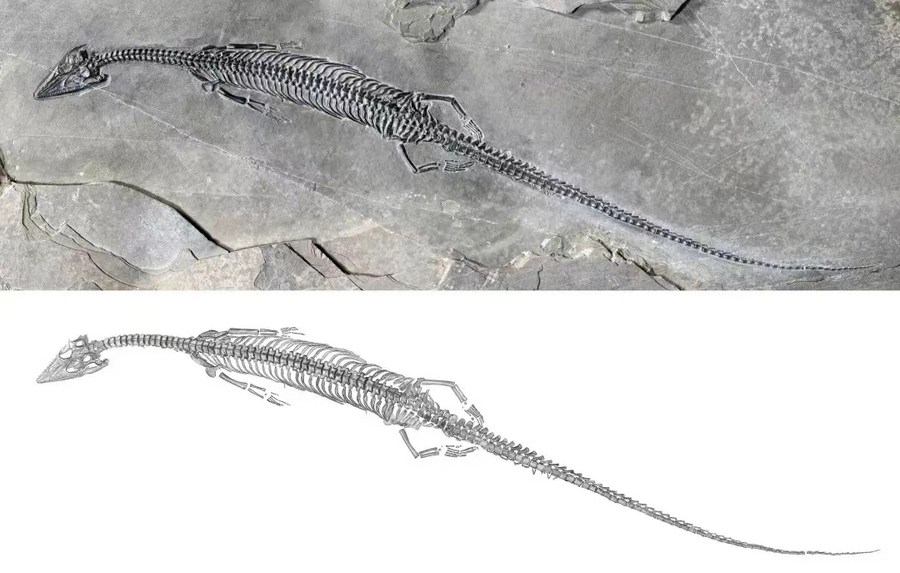Chinese scientists find fossil of new marine reptile with "incredibly long" tail

This undated photo shows the fossil specimen and sketch of Honghesaurus, a new species of marine reptiles known as a pachypleurosaur.(Chinese Academy of Sciences/Handout via Xinhua)
BEIJING, May 11 (Xinhua) -- Chinese scientists have discovered a fossil of a new species of marine reptiles known as a pachypleurosaur, dating back 244 million years, with the longest tail ever seen for its kind, indicating it may have been an exceptional swimmer.
The pachypleurosaurs were a group of small to medium-sized, lizard-like marine reptiles from the early to middle Triassic Period, and the new species has been named Honghesaurus after the discovery site Honghe Hani and Yi Autonomous Prefecture.
At 25.4 cm, the tail made up more than half the length of the creature, estimated at 47.1 cm. Scientists found it had a total of 121 vertebrae, including 69 caudal, or tail, vertebrae, beating the previous record of 58 caudal vertebrae in other pachypleurosaurs.
Researchers from the Institute of Vertebrate Paleontology and Paleoanthropology under the Chinese Academy of Sciences found the fossil in southwest China's Yunnan Province last year.
"It was shaped like an aquatic lizard with a long trunk, but its super-long tail was much longer than other parts of its body," said lead researcher Xu Guanghui.
Most pachypleurosaurs were small with a maximum length rarely exceeding 50 cm. The long trunk associated with an incredibly long tail could provide the reptile the advantage of maneuverability and energy efficiency for swimming, Xu noted in the study, which was published in the journal Scientific Reports last week.
Apart from providing new insights into the ecological adaption of this reptile group, the discovery was also the oldest fossil evidence of the pachypleurosaurid marine reptile species in China.
The first named marine reptile discovered in China was also a pachypleurosaur, namely Keichousaurus, found in 1957.
Co-author Zhao Lijun, researcher at Zhejiang Museum of Natural History, said the long-tailed Honghesaurus is 4 million years older than the Keichousaurus, and more closely related to the pachypleurosaurids found in Europe, representing the oldest record of this family in China.
Photos
Related Stories
- 390 million-year-old lungfish fossils found in Yunnan
- Marine reptile fossil dating back 250 million years found in south China
- First daytime active owl fossil found in China: study
- Feature: Wetland in Beijing welcomes "living fossil" Chinese merganser duck
- 169-mln-yr-old new-species stegosaur fossil discovered in China
Copyright © 2022 People's Daily Online. All Rights Reserved.










